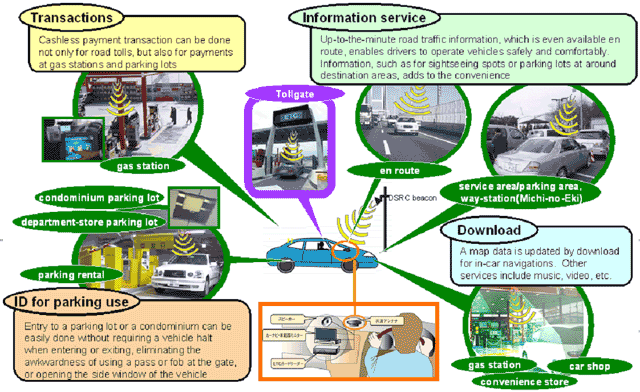

Major Themes for FY2004
Policies for FY2004To provide solutions for road traffic problems such as congestion, accidents and environmental degradation; to enhance serviceability and convenience for users as well as revitalizing economic activities by creating new businesses; to expedite the widespread use of ETC and promote utilization of ETC applications; to support varied service operations using ETC communication technology and promote R&D to commence varied ITS services 1) Promotion of ETC use for widespread ETCETC system (non-stop toll collection payment system), which allows tollgates to enhance serviceability through tie-up alleviation and cashless transactions, started its service operations in March 2001 and further completed cross-national deployments by the end of March 2004. Additionally, in fiscal 2003 we offered grants to frequent toll-road users for 'financial aid for ETC monitor and lease' as well as conducting 'ETC long distance discounts trial tests' in expressways or 'nighttime discounts trial tests in Metropolitan expressways.' Discount promotions are underway by way of the nationwide ETC promotion. As of February 2004, the number of marketed ETC onboard units has reached about 2.5 million and ETC use ratio in toll roads is 14.8% on the national average. Furthermore, to achieve 70% ETC use by the end of fiscal 2007 for tie-up dissipation at toll gates and environmental improvement in vicinity areas, the ETC promotional effort will be strengthened, together with road capacity enhancement efforts, by applying varied and flexible toll charge systems. Also, community tests are planned to examine the accessibility of 'Smart Interchange' to expressways, which additionally places an entrance/exit at existing service areas or parking areas using ETC toll gates. 2) Varied services support using ETC communication technologyTo create an ITS market and achieve further penetration of ETC use, joint efforts between the public and industry are proceeding to allow vehicles to enter/exit from parking lots without requiring a halt using toll collection systems, to commence a public information service via in-car navigation systems about rest areas and facilities, and to provide assistance for private industries.  3) Driver assistanceTo assist a driver for vehicle operations, R&D on safe vehicle operations assistance is proceeding using ETC communication technology and digital road maps. 4) Pedestrian assistanceTo support pedestrians for comfortable mobility environments, an information service about transit transportations and barrier-free access is being promoted for pedestrian mobile terminals. 5) Regional ITS promotion including ITS facility development programsITS, featuring both extensibility and interoperability, is poised to expand across the nation and is positioned at the forefront of national initiatives based on the defined system architectures as well as the positive effort to introduce ITS into the local areas. Road administrators and operators use 'ITS facility development program aid' to provide parking availability information, or road traffic message systems along roads, at roadway station. 6) Information platform buildingTo promote transparent road administrations through open information access and reliable road networks, particularly when disaster occurs, an information platform is constructed to share information on road traffic or disasters with other regional or municipal offices. Also, to support building of optic-fiber cable networks of vendors, the existing optic-fiber networks for road control and maintenance use is open to the private sector. 7) International Standardization activitiesFor ITS of Japan to succeed, achieving the technical requirements for wireless communications and taking part in the international standardization activities of the International Telecommunication Union are required. Additionally, three ministries and one agency are cooperatively participating in standardization activities led by the International Organization for Standardization. The study field in fiscal 2003 focused particularly on map, vehicle sensing, and road-roadside communication. This effort is continuing in fiscal 2004 to establish the action plans. 8) International CooperationThe three ministries and one agency are collaboratively proceeding with international cooperation. Activities range from exchanges for ITS R&D to support ITS World Congress aiming at ITS implementations in the real world. |
|
| |
All Rights Reserved, Copyright © 2004 Ministry of Land, Infrastructure, Transport and Tourism |